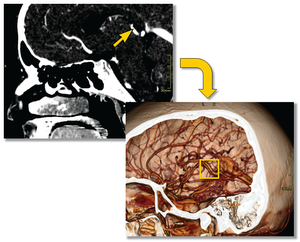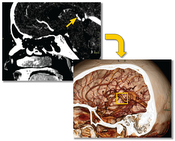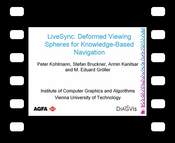Information
- Publication Type: Journal Paper with Conference Talk
- Workgroup(s)/Project(s):
- Date: October 2007
- Journal: IEEE Transactions on Visualization and Computer Graphics
- Volume: 13
- Number: 6
- Note: to be presented at IEEE Visualization 2007
- Location: Sacramento, California, USA
- Lecturer: Peter Kohlmann
- Event: IEEE Visualization 2007
- Conference date: 28. October 2007 – 1. November 2007
- Pages: 1544 – 1551
- Keywords: linked views, interaction, medical visualization, navigation, viewpoint selection
Abstract
Although real-time interactive volume rendering is available even for very large data sets, this visualization method is used quite rarely in the clinical practice. We suspect this is because it is very complicated and time consuming to adjust the parameters to achieve meaningful results. The clinician has to take care of the appropriate viewpoint, zooming, transfer function setup, clipping planes and other parameters. Because of this, most often only 2D slices of the data set are examined. Our work introduces LiveSync, a new concept to synchronize 2D slice views and volumetric views of medical data sets. Through intuitive picking actions on the slice, the users define the anatomical structures they are interested in. The 3D volumetric view is updated automatically with the goal that the users are provided with expressive result images. To achieve this live synchronization we use a minimal set of derived information without the need for segmented data sets or data-specific pre-computations. The components we consider are the picked point, slice view zoom, patient orientation, viewpoint history, local object shape and visibility. We introduce deformed viewing spheres which encode the viewpoint quality for the components. A combination of these deformed viewing spheres is used to estimate a good viewpoint. Our system provides the physician with synchronized views which help to gain deeper insight into the medical data with minimal user interaction.Additional Files and Images
Weblinks
No further information available.BibTeX
@article{kohlmann-2007-livesync,
title = "LiveSync: Deformed Viewing Spheres for Knowledge-Based
Navigation",
author = "Peter Kohlmann and Stefan Bruckner and Armin Kanitsar and
Eduard Gr\"{o}ller",
year = "2007",
abstract = "Although real-time interactive volume rendering is available
even for very large data sets, this visualization method is
used quite rarely in the clinical practice. We suspect this
is because it is very complicated and time consuming to
adjust the parameters to achieve meaningful results. The
clinician has to take care of the appropriate viewpoint,
zooming, transfer function setup, clipping planes and other
parameters. Because of this, most often only 2D slices of
the data set are examined. Our work introduces LiveSync, a
new concept to synchronize 2D slice views and volumetric
views of medical data sets. Through intuitive picking
actions on the slice, the users define the anatomical
structures they are interested in. The 3D volumetric view is
updated automatically with the goal that the users are
provided with expressive result images. To achieve this live
synchronization we use a minimal set of derived information
without the need for segmented data sets or data-specific
pre-computations. The components we consider are the picked
point, slice view zoom, patient orientation, viewpoint
history, local object shape and visibility. We introduce
deformed viewing spheres which encode the viewpoint quality
for the components. A combination of these deformed viewing
spheres is used to estimate a good viewpoint. Our system
provides the physician with synchronized views which help to
gain deeper insight into the medical data with minimal user
interaction.",
month = oct,
journal = "IEEE Transactions on Visualization and Computer Graphics",
volume = "13",
number = "6",
note = "to be presented at IEEE Visualization 2007",
pages = "1544--1551",
keywords = "linked views, interaction, medical visualization,
navigation, viewpoint selection",
URL = "https://www.cg.tuwien.ac.at/research/publications/2007/kohlmann-2007-livesync/",
}


 paper
paper

